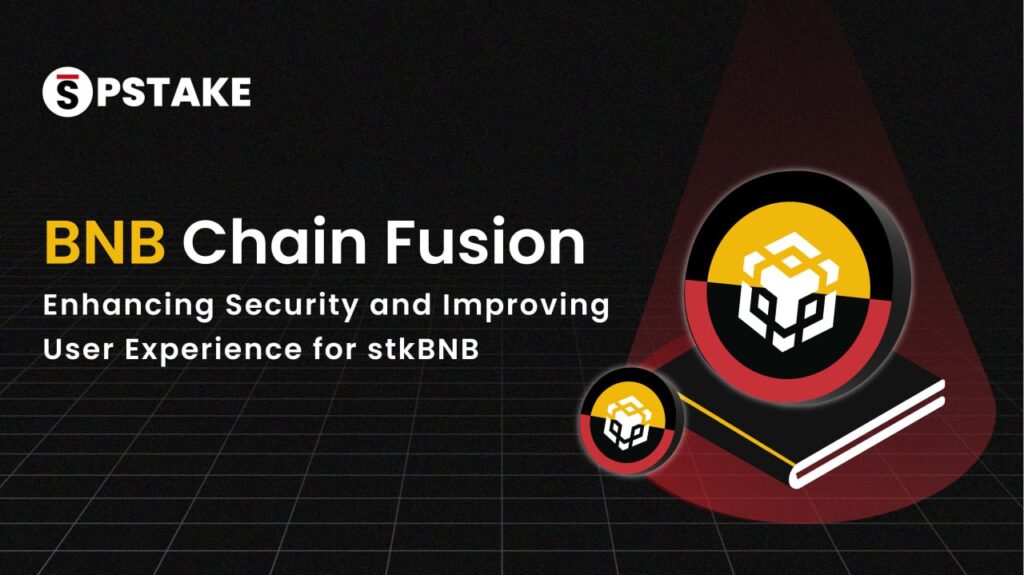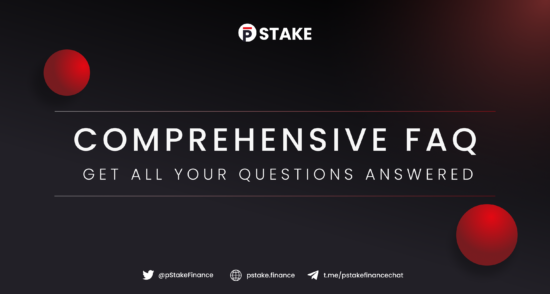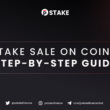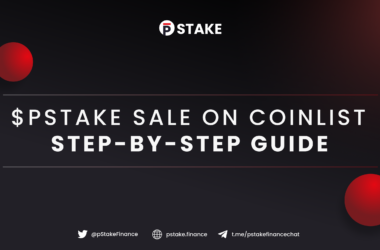To find an answer to a specific question, press Ctrl+F (on Windows) or Command+F (on Mac) and search for the relevant word or phrase.
General Resources
♦️Website: https://pstake.finance
♦️Docs: https://docs.pstake.finance
♦️Blog: https://blog.pstake.finance
♦️pSTAKE Zero to One: https://bit.ly/pSTAKE0to1
♦️pSTAKE Video Tutorial (Keplr): https://youtu.be/lFkLL2Fjag4
♦️pSTAKE Video Tutorial (Ledger): https://youtu.be/a6uxQkN4ljs
♦️$PSTAKE Public Sale on CoinList Details: https://coinlist.co/pStake
♦️$PSTAKE Sale on CoinList: Step-by-Step Guide: https://bit.ly/pSTAKECoinList
FAQ Contents
- pSTAKE Basics
- $PSTAKE Token
- $PSTAKE Public Sale on CoinList
- Using pSTAKE Application
- Other
1. pSTAKE Basics
What is pSTAKE?
pSTAKE is a liquid staking protocol, developed by Persistence, unlocking the liquidity of staked assets. Holders of PoS tokens can now stake their assets via pSTAKE while maintaining the liquidity of these assets. By staking with pSTAKE, users receive 1:1 pegged representative tokens (stkTOKENs) which earn staking rewards and can also be used in DeFi to generate additional yield (yield on top of staking rewards).
See the video here for an introduction to pSTAKE:
Which assets does pSTAKE support?
pSTAKE currently supports liquid staking for ATOM (the native token of Cosmos) and XPRT (the native token of Persistence).
pSTAKE will continue to launch liquid staking support for more major PoS assets — from both within and outside the Cosmos ecosystem. This includes ETH, LUNA, SOL, and many others.
What are pTOKENs and stkTOKENs?
pTOKENs are ERC-20 tokens which function as 1:1 pegged representatives of native PoS tokens that are not staked on the underlying network. When a user deposits (or wraps) PoS tokens via pSTAKE, they receive pTOKENs in their wallet (e.g. ATOM to pATOM). Holders of pTOKENs can instantly withdraw the underlying PoS tokens by unwrapping their corresponding pTOKENs via pSTAKE.
stkTOKENs are ERC-20 tokens which represent pTOKENS which a user has staked via the pSTAKE platform. Once the user’s pTOKENS are staked via the pSTAKE platform, they receive stkTOKENS in their wallet (e.g. pATOM to stkATOM).
In addition to receiving staking rewards in the form of pTOKENs, stkTOKEN holders are able to utilize stkTOKENs in the vast DeFi ecosystem on Ethereum. For example, there are liquidity pools for both stkATOM & stkXPRT on SushiSwap.
How is asset issuance done via pSTAKE?
pSTAKE is powered by pBridge which allows issuance of multichain assets and enables transfer of value between multiple disparate blockchains such as Ethereum, Cosmos, Persistence etc. Unlike other bridges available in the blockchain ecosystem which only facilitate the creation of peg tokens, pBridge can also perform interchain transactions pertaining to PoS staking and unstaking, which are fulfilled at the protocol level on the native chain.
How does pSTAKE secure the staked assets?
The assets deposited onto pSTAKE are delegated to some of the most reputed validators in the industry. These validators are a subset of the validators of the underlying PoS chain. To learn more about our validator set, refer to https://pstake.finance/.
What are the rewards for staking via pSTAKE?
Users currently staking their stkATOM are receiving 7% APR and 32.99% APR for staking their stkXPRT – on top of additional yield for holders using their stkTOKENs in DeFi.
Can I use my stkTOKENs in DeFi currently?
Yes, you can. pSTAKE has whitelisted the stkATOM-ETH and stkXPRT-ETH pools on Sushiswap to enable users to earn both staking rewards and trading fees (in addition to retroactive $PSTAKE rewards) by providing liquidity and using pSTAKE’s Stake LP function. More pools will be whitelisted in the near future.
What is Stake LP?
Stake LP is a feature built into pSTAKE which allows users to take their LP tokens from DEXs like SushiSwap and stake them for more rewards. Currently, to be eligible for retroactive rewards, users must stake their LP tokens via the Stake LP interface.
For detailed guidance on how to provide pool liquidity and use pSTAKE’s Stake LP function, see the video here (using Keplr) or here (using Ledger), or refer to the documentation page here.
Has pSTAKE protocol’s code been audited?
Yes, pSTAKE has now been audited by three of the industry’s top auditing firms – PeckShield, Solidified and ConsenSys Diligence.
2. $PSTAKE Token
What is $PSTAKE token?
$PSTAKE is the native governance token of the pSTAKE protocol. It is an ERC20 token issued on the Ethereum network.
What is the contract address for the $PSTAKE token? When is the TGE?
The TGE (token generation event) of $PSTAKE has not yet taken place, so there is no contract address. If you see any $PSTAKE token trading on the market currently, it is a scam.
What is the function of $PSTAKE?
$PSTAKE intends to provide its holders with a two-fold benefit, including:
- Participation in protocol improvement proposals through voting
- Participation in protocol security
$PSTAKE is the governance and incentivization/dis-incentivization token of the pSTAKE protocol. $PSTAKE holders can participate in the protocol’s governance to ensure its long-term success by staking $PSTAKE via the pSTAKE staking contract to secure the protocol while being incentivized to do so. $PSTAKE token will also be used as a dis-incentivization token in case stakeholders staking $PSTAKE act maliciously or are unable to perform their respective duties appropriately.
What is the total supply of $PSTAKE?
$PSTAKE has a total genesis supply of 500,000,000 (500M) tokens.
Where can I read more about $PSTAKE?
More details about the $PSTAKE token and the stakeholders in the pSTAKE ecosystem can be found here.
Where can I see the tokenomics?
We will publish an article outlining the full $PSTAKE tokenomics in the coming days.
How can I buy $PSTAKE tokens?
The only way to acquire $PSTAKE tokens currently is the upcoming public sale on CoinList. There are no other sales ongoing and $PSTAKE token is not yet trading on exchanges.
3. $PSTAKE Public Sale on CoinList
Note: Please see here for a dedicated step-by-step guide on how to participate in the public sale.
What is the $PSTAKE public sale?
The $PSTAKE public sale, taking place on CoinList, is an opportunity for community members to acquire pSTAKE’s native governance token ($PSTAKE) before the token generation event (TGE).
Sale period for $PSTAKE sale on CoinList:
Registration Opens: December 7, 2021
Registration Deadline: December 13, 2021 at 23:59 UTC
Sale Period Begins: December 16, 2021 at 18:00 UTC
Sale Period Ends: December 22, 2021 at 23:59 UTC
Where can I participate in the token sale?
The sale will take place on CoinList. You can register here.
To access CoinList directly, please use https://coinlist.co/. Please be aware of scams. These are the only links which you should access the sale.
Disclaimer: The $PSTAKE token sale is not available to citizens of The United States, Canada, China and other restricted jurisdictions.
Why can’t U.S., Canadian, South Korean, Chinese and other restricted residents participate in the pSTAKE sale?
pSTAKE is committed to following all relevant regulatory guidelines. Due to regulatory uncertainty, pSTAKE will not be able to offer pSTAKE tokens for purchase during the $PSTAKE token sale to certain prospective participants including those in the U.S., Canada, South Korea, and China.
Is there a tutorial or guide on how to participate in the sale?
Yes, please see here for a dedicated step-by-step guide.
Where can I receive support from CoinList?
If you have any queries regarding the CoinList process, please raise a ticket on the CoinList support page.
How will the sale work?
Users who successfully registered for the token sale will receive an email with a unique link to enter the queue prior to the start of the sale. It will also be available on your logged-in dashboard and on CoinList. You can enter the waiting room up to 24 hours before the start of the sale. Everyone in the waiting room before the start of the sale will be assigned a random spot in line. Users arriving after the sale starts get a first-come, first-served place in at line after those in the waiting room.
- Wait in line as we process participation. We expect all options to take a few hours to process. Please note, securing an allocation will be highly competitive.
- Once you’ve made it through the queue, you will be displayed payment options to complete your purchase. You do not need to send in funds prior to the sale, you have until Dec 16, 18:00 PM UTC to finalise your purchase. If you secure an allocation and do not fund your allocation by the deadline, you will be unable to secure future allocations in CoinList sales. Once payment is received, you’ll receive a confirmation of purchase email.
- CoinList will send an update email with token delivery instructions after the sale closes (December 22).
- As a reminder, you must purchase with your assigned queue ID / queue link. Purchases using invalid IDs will be cancelled and banned from future sales.
Can you tell me more about how the sale queue system works?
The following is a description of CoinList’s sale queue system:
- Users registered for a sale will receive an email with a link to enter the queue prior to the start of the sale.
- To access the link, log in to your CoinList account associated with the email address that received the link.
- This link (also available on your dashboard + deal page) will direct you to a URL unique to your account and gives you one spot in the queue. After you pass the queue and enter the sale site, do not use your link again. Doing so will result in loss of access to the sale
- All users arriving at the queue before the start of the sale will be placed in a waiting room. Please note that arriving at the waiting room early does not give you a better place in the queue.
- When the sale starts, users in the waiting room are assigned a random place in line, ahead of those who arrive after the sale starts.
- Users arriving after the sale starts get a first-come, first-served place in line after those in the waiting room.
- When it is your turn, you will have 10 minutes to enter.
- Your purchase will be finalized when your deposit clears. You do not need to pre-fund. If your deposit doesn’t clear immediately, that’s fine.
- As a reminder, CoinList prohibits the use of bots. If you use bots to purchase tokens, your account will be terminated (and potentially lose funds) and your purchases will be cancelled.
- Beware of phishing attacks and CoinList impersonators during this time of heightened interest.
What is the sale priority queue?
CoinList priority queue is an invite-only queue that is significantly shorter than the main sale queue, running in parallel to the main queue, giving the invitees a much higher chance of securing an allocation.
Priority queue invites are usually only granted to long-term CoinList users. For the $PSTAKE sale, however, pSTAKE protocol users will also be given access to the priority queue (in addition to other select individuals, as determined by CoinList), based on pre-determined eligibility criteria.
Who will receive priority queue access for the $PSTAKE public sale and how will it work?
To encourage users to contribute to the growth of the pSTAKE protocol, CoinList is offering registered users of the pSTAKE token sale an opportunity at receiving a priority queue invitation by satisfying one of the following criteria:
For existing pSTAKE users
All users who have performed ANY ONE of the following actions via the pSTAKE application before the announcement of the $PSTAKE token sale are automatically eligible for the priority queue:
- Deposit native assets (ATOM or XPRT) to mint pTOKENs.
- Stake pTOKENs to mint stkTOKENs.
- Claim rewards accrued on the staked stkTOKENs.
- Unstake stkTOKENs to mint pTOKENs.
- Withdraw pTOKENs to withdraw native assets.
Note: Snapshot was taken at 00:00 UTC 8th December, 2021.
For new pSTAKE users
If you have not used pSTAKE yet, you can still be eligible by executing ANY ONE of the below actions before the $PSTAKE public sale registration deadline (December 13 at 23:59 UTC):
- Mint stkATOM: Use the pSTAKE application to mint stkATOM by depositing ATOM (purchasing stkATOM from existing liquidity pools is not an eligible action).
- Mint stkXPRT: Use the pSTAKE application to mint stkXPRT by depositing XPRT (purchasing stkXPRT from existing liquidity pools is not an eligible action).
- Supply liquidity to the stkATOM/ETH pool on SushiSwap: After providing liquidity in the pool, you must stake your LP tokens with pSTAKE or else you will be deemed ineligible.
- Supply liquidity to the stkXPRT/ETH pool on SushiSwap: After providing liquidity in the pool, you must stake your LP tokens with pSTAKE or else you will be deemed ineligible.
See our pSTAKE: Zero to One article or our documentation for guidance on how to use pSTAKE. pSTAKE user video tutorials are available here (for Keplr users) and here (for Ledger users).
Users must submit their wallet address and sign a provided message in the registration flow of the token sale to be eligible. pSTAKE will randomly select users who satisfy the above criteria to be invited to the priority queue for the pSTAKE token sale.
CoinList may also prioritise access to the pSTAKE token sale for certain users due to past contributions to their respective communities. Having a track record of multiple value-add activities increases the chances that you’re invited to the priority queue. This includes validators, miners, stakers, active traders, liquidity providers, hackathon participants, and early token sale participants (2020 and earlier).
CoinList may in its sole and absolute discretion adjust the parameters of the CoinList website and/or access systems to prioritise access for those users to the pSTAKE sale. Please note that such users ARE NOT GUARANTEED access to the token sale.
How do I submit my signature to register for the priority queue?
Please see the ‘Priority Queue Registration’ section of the guide here for step-by-step instructions.
How do I fund my purchase?
CoinList will display payment information once the Sale Period starts. You can pay with
USDT, USDC, BTC, ALGO, SOL or ETH. Payments made in USDT (“Tether”) or USDC (“USD Coin”) will equate to the value of one U.S. Dollar (“USD”) regardless of fluctuations in USDT or USDC.
If you fund your account and purchase tokens with USDC or USDT, there are no fees. You can deposit USDC and USDT into your CoinList Wallet anytime at https://coinlist.co/wallets.
If you fund your account and purchase with ETH or BTC, it will be converted to USDC at the time of purchase. An estimated conversion rate will be shown at the time of purchase and you will also incur a 0.50% transaction fee from CoinList for converting such funds. All purchases will be denominated in USD. You can deposit ETH and BTC into your CoinList Wallet anytime at https://coinlist.co/wallets.
Is there a fixed price for the token sale or do we get options?
The price is fixed at $0.40 per $PSTAKE token for the CoinList public sale.
Is there a cap amount for the purchase?
Yes.
Minimum Purchase: $100
Maximum Purchase: $500
What is the lock-up and release schedule of tokens sold in the $PSTAKE public sale?
25% unlock at TGE (date TBD), followed by a 6-month linear vesting schedule.
Can I participate in the sale without undergoing KYC?
No. Anyone who wants to participate in the sale must undergo KYC/AML (Know Your Customer/Anti-Money Laundering) checks.
4. Using pSTAKE Application
Note: pSTAKE user video tutorials are available here (for Keplr users) and here (for Ledger users).
How do I acquire assets to use on pSTAKE?
pSTAKE currently supports liquid staking for ATOM and XPRT, both of which can be acquired on a variety of centralized and decentralized exchanges.
You can find the list of ATOM-supporting exchanges here and XPRT-supporting exchanges here.
How do I log into pSTAKE to start using the app?
You can begin using pSTAKE by signing in via any of the following wallets:
- MetaMask
- WalletConnect
- WalletLink
As you sign into your Ethereum account, ensure that the MetaMask extension is installed and added to your browser.
Recommended browser: Chrome.
Do I need any other wallet/s to use pSTAKE?
Yes, you will also need the Keplr wallet extension installed and added to your browser.
Why are both MetaMask and Kelpr wallets required?
You will need Keplr wallet installed in order to deposit your ATOM or XPRT tokens from Keplr to pSTAKE for wrapping (or withdraw them when unwrapping).
Once these assets are wrapped on the Ethereum mainchain they become pTOKENS (ERC-20 based 1:1 pegged representatives of the PoS token). pTOKENS are ERC-20 tokens that reside within your Ethereum wallet (E.g. MetaMask). MetaMask is used to facilitate the transactions between your newly minted ERC-20 tokens and the pSTAKE protocol. Furthermore, the user’s stkTOKENs (staked pTOKENs) will require MetaMask to help facilitate transactions within the vast Ethereum DeFi ecosystem (E.g. SushiSwap & StakeLP).
Can I use Ledger wallet?
Yes, users can utilize the Ledger hardware wallet for an extra layer of security. Please watch our easy-to-use guide for more information.
Can you explain the difference between pTOKENs and stkTOKENs?
pTOKENs are ERC-20 tokens which function as 1:1 pegged representatives of native PoS tokens that are not staked on the underlying network. When a user deposits (or wraps) PoS tokens via pSTAKE, they receive pTOKENs in their wallet (e.g. ATOM to pATOM). Holders of pTOKENs can instantly withdraw the underlying PoS tokens by unwrapping their corresponding pTOKENs via pSTAKE.
stkTOKENs are ERC-20 tokens which represent pTOKENS which a user has staked via the pSTAKE platform. Once the user’s pTOKENS are staked via the pSTAKE platform, they receive stkTOKENS in their wallet (e.g. pATOM to stkATOM).
In addition to receiving staking rewards in the form of pTOKENs, stkTOKEN holders are able to utilize stkTOKENs in the vast DeFi ecosystem on Ethereum. For example, there are liquidity pools for both stkATOM & stkXPRT on SushiSwap.
How do I wrap and stake my assets on pSTAKE to receive stkTOKENs?
There are dedicated video tutorials to guide you through the process, whether you use Keplr or Ledger.
Keplr tutorial:
Ledger tutorial
Once you follow the first two steps outlined in the videos, you will see your stkTOKENs in your MetaMask wallet. While also earning staking rewards, these stkTOKENs are free to be used within DeFi protocols on Ethereum for additional yield (step 3 in the tutorial videos above).
How does staking / unstaking work on the pSTAKE application?
pSTAKE allows users to stake a portion or all of their deposited native PoS assets (such as ATOM), on the network through pSTAKE’s staking dashboard. Staking through pSTAKE allows users to earn network staking rewards and in return also receive ERC-20 based stkTOKENs which are 1:1 pegged with the native staked token.
Unstaking is the process of exiting a staking position which reduces the user’s stkTOKEN balance by burning the number of stkTOKENs unstaked and minting an equivalent amount of pTOKENs (barring a small deviation due to fees). This process is not instantaneous and users have to wait for the completion of the unbonding period defined by the native network before they can receive pTOKENs. Find instructions for the staking / unstaking operations.
How are staking rewards accumulated? How do I view / claim staking rewards?
If you have stkTOKENs in your wallet, staking rewards accrue automatically during every block creation of the native blockchain (Cosmos for stkATOM or Persistence for stkXPRT) in the form of pTOKENs.
You can view your unclaimed rewards in the right pane of the pSTAKE application, the ‘Unclaimed Rewards’ region. You can use the ‘Claim Now’ button in the Unclaimed Rewards card to claim your rewards. Users can claim rewards at any time.
Are there any transaction / network fees charged to wrap tokens?
To wrap the tokens, the users need to deposit their native tokens on pSTAKE and the protocol issues 1:1 pegged ERC20-based pTOKENs into the users’ Ethereum wallet address connected to the application.
The following transaction fees are incurred by the user while performing the wrap transaction:
- Transfer TX Fees: Fees charged on the native chain to deposit the chosen amount of native assets from the user’s wallet address into pSTAKE. This fees is charged by the native chain and depends on the network congestion at the time and user’s gas settings
- Minting Fees: This fee is charged by the pSTAKE protocol for issuing the ERC20-based pTOKENs into the user’s Ethereum wallet address. This fee is set currently at 0% to incentivise early users.
Are there any transaction / gas fees required to stake wrapped tokens?
Yes, users will pay the going rate based on the congestion of the Ethereum mainchain while attempting to stake their wrapped tokens. Moreover, these costs will depend on the user’s gas settings and opted transaction speed.
Is the transaction fees charged from MetaMask wallet or from Keplr wallet?
The wallet charging the transaction fees depends on the type of transaction:
- Wrap: Keplr
User has to deposit native assets from native wallet address into pSTAKE.
- For all other transactions (Stake/Unstake, Claim rewards, Unwrap, Approve/Stake LP): MetaMask
User has to interact with the ERC20-based pTOKENs/stkTOKENs for these transactions.
Do I get rewards for wrapping assets?
No, users will not receive rewards for wrapping tokens for now.
The user has to staked their wrapped asset (burn pTOKENs to mint stkTOKENs) to earn staking rewards.
How can I earn DeFi rewards on top of staking rewards?
stkTOKEN holders can provide liquidity into SushiSwap pools and stake their LP tokens via pSTAKE to earn pool trading fees on top of the staking rewards.
pSTAKE has whitelisted the stkATOM-ETH and stkXPRT-ETH pools on Sushiswap to enable users to earn both staking rewards and trading fees (in addition to retroactive $PSTAKE rewards) by providing liquidity and using pSTAKE’s Stake LP function. More pools will be whitelisted in the near future.
Note: The users lose their staking rewards if they don’t Stake their LP tokens back with pSTAKE.
How do I provide liquidity to stkTOKEN/ETH pools on SushiSwap?
Once the user has their stkTOKENS they will be required to have the equivalent amount of ETH in USD value as the value of the stkTOKENS they wish to deploy to SushiSwap. The user will need to visit the correct SushiSwap pool to get started.
For the stkATOM-ETH pool click here.
For the stkXPRT-ETH pool click here.
For detailed guidance on how to provide pool liquidity and use pSTAKE’s Stake LP function, see the video here (using Keplr) or here (using Ledger), or refer to the documentation page here.
5. Other
Where can I find more information about the $PSTAKE airdrop?
We previously announced a retroactive token airdrop to the critical stakeholders within the protocol’s ecosystem to ensure alignment of incentives and foster long-term growth of the protocol.
To learn more about the $PSTAKE Airdrop, please refer to the $PSTAKE Airdrop Explained article.
There is also an airdrop-focused AMA here:
Where can I find more information about pSTAKE’s backers / investors?
pSTAKE recently raised $10M in a strategic funding round led by Three Arrows Capital, Sequoia India, Galaxy Digital, and Defiance Capital to bootstrap the liquid staking protocol.
Learn more and meet our investors here.
Can you explain pSTAKE’s roadmap?
pSTAKE has launched liquid staking support for Cosmos’ ATOM and Persistence’s XPRT tokens, with support for more assets such as ETH (Ethereum), SOL (Solana), and other Cosmos-based assets coming soon. Since launch, more than $32M of ATOM and XPRT has been staked by pSTAKE users.
Currently, pSTAKE issues 1:1 pegged ERC-20 liquid staking representative tokens on the Ethereum network, and a Cosmos-based implementation of the pSTAKE protocol is also in the works. Other current focuses of the pSTAKE team include bootstrapping DeFi use-cases of stkTOKENs (such as lending/borrowing, perpetuals, yield farming etc), and the $PSTAKE token TGE following the concussion of the $PSTAKE public sale on CoinList (TGE details to be announced at a later date).
A more detailed roadmap will be released in the coming days.
Where can I find answers to more technical questions regarding the protocol?
A more technical FAQ section can be found in our documentation here.
I have another question that hasn’t been answered here. Where can I go for support?
Feel free to reach out in our Telegram community group and our admins or team will gladly assist.
About pSTAKE
pSTAKE is a liquid staking protocol that unlocks liquidity for your staked assets. With pSTAKE, you can securely stake your Proof-of-Stake (PoS) assets, participate in protocol improvements and security to earn staking rewards, and receive staked underlying representative tokens (stkASSETs) which can be used to explore additional yield opportunities across DeFi.
At present, pSTAKE supports Binance Chain (BNB), Cosmos (ATOM), Persistence (XPRT), and Ethereum (ETH) networks’ native tokens, with a view to support more chains and assets in the future (SOL, and AVAX).
Developed by Persistence
Persistence is a Tendermint-based, specialised Layer-1 network powering an ecosystem of DeFi applications focused on unlocking the liquidity of staked assets. Persistence facilitates the issuance and deployment of liquid-staked stkASSETs, allowing users to earn staking rewards while participating in DeFi primitives, such as lending/borrowing and liquidity provisioning on DEXs.
Persistence aims to offer a seamless staking and DeFi experience for PoS (Proof-of-Stake) users and enable developers to build innovative applications around stkASSETs.
Join Our Movement
Twitter | LinkedIn | Telegram | YouTube | Reddit | [email protected]










